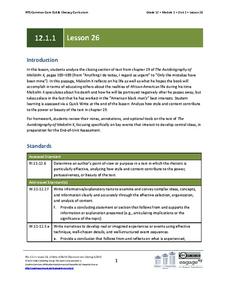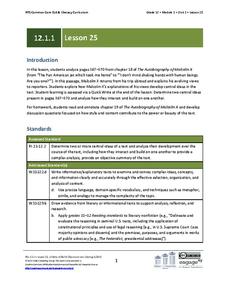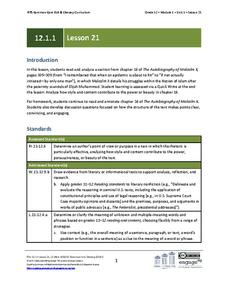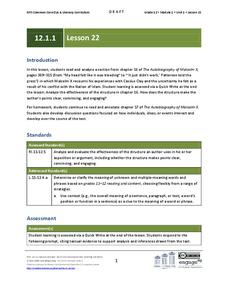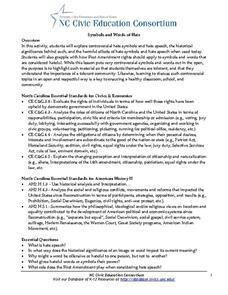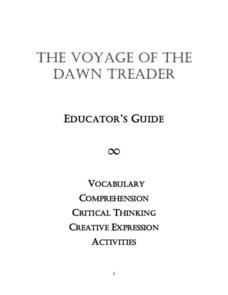K20 LEARN
The History of Spoken Word Poetry: Historical and Cultural Perspectives In Literature
Spoken word poetry, more than almost any other form, reveals the historical and cultural perspective of the poet. High schoolers listen to various spoken word poems, select one to research in-depth, and then apply what they have learned...
K20 LEARN
Speak Your Truth: Techniques in Spoken Word Poetry
As part of a study of Spoken Word Poetry, class members watch a series of performance videos and note where poets get their ideas and the performance techniques used by the poets. Pupils then draft and share their poems.
K20 LEARN
Speak Up! Four Categories Of Speeches
High schoolers examine the four major types of speeches: informative, demonstrative, persuasive, and extemporaneous. Groups then select one type and craft and share a presentation highlighting this format's characteristics. Finally,...
EngageNY
Grade 12 ELA Module 1: Unit 1, Lesson 26
Readers use their annotations and questions about chapter 19 of The Autobiography of Malcolm X to guide their discussion of the final chapter of the text.
EngageNY
Grade 12 ELA Module 1: Unit 1, Lesson 25
Class members return to the discussion of The Autobiography of Malcolm X using the questions they developed and their annotated notes of the events in chapter 17.
EngageNY
Grade 12 ELA Module 1: Unit 1, Lesson 19
Class members return to a discussion of The Autobiography of Malcolm X, discussing how Haley foreshadows the growing distrust and downturns in the influence of the Nation of Islam.
EngageNY
Grade 12 ELA Module 1: Unit 1, Lesson 21
". . .the chickens have come home to roost." Chapter 16 of The Autobiography of Malcolm X is the focus of this lesson plan. Readers use their worksheets to record evidence of character development and Haley's stylistic choices that...
EngageNY
Grade 12 ELA Module 1: Unit 1, Lesson 22
Using their annotations and questions developed as homework, class members discuss chapter 16 of The Autobiography of Malcolm X and the narrative techniques Haley uses to heighten the tension and power of the events at this turning point...
EngageNY
Grade 12 ELA Module 1: Unit 1, Lesson 17
Integration versus separation. Readers of chapter 14 of The Autobiography of Malcolm X examine Malcolm X's views on other Civil Rights leaders and their integration ideas. Class members also return to the narrative essay strand of the...
EngageNY
Grade 12 ELA Module 1: Unit 1, Lesson 9
As they read and discuss Chapter 7 of The Autobiography of Malcolm X, class members continue to use the Tracking Tool worksheet to record evidence on how the central ideas are being developed.
National Endowment for the Humanities
Lesson 2 James Madison: The Second National Bank—Powers Not Specified in the Constitution
How much power is too much power for the federal government? Scholars use primary documents and constitutional research in groups to analyze the creation of the Second National Bank under James Madison. This is the second lesson of a...
National Endowment for the Humanities
Kate Chopin's The Awakening: Searching for Women and Identity in Chopin's "The Awakening"
The final activity of a three-part series on Kate Chopin's The Awakening has scholars investigate life as a woman in late nineteenth-century America. They research the role of women in society through the eyes of the characters in the...
Media Smarts
Defining Popular Culture
What part does media play in creating, defining, and perpetuating popular culture? High schoolers chart their encounters with fads, trends, and icons and reflect on the media's influence on popular culture.
Curated OER
Popular Music and Music Videos
This resource is part of a three-activity unit that introduces your class to the concept of popular culture and the role that it plays in their lives. Here, learners examine the importance of the music industry and music videos in pop...
University of North Carolina
Symbols and Words of Hate
This resource is structured with exercises that ask class members to explore hate symbols and hate speech. Learners examine the historical significance and harmful effects of these words and symbols, examine the First Amendment and...
Digital History
Representation: By State or by Population
Should representation in the new United States government be based on population? This worksheet illustrates the details of this important quandary through an adaptation of speeches on the topic given at the Constitutional Convention....
Curated OER
Epic Improvisation
Really? Rapping The Odyssey? Really. A discussion of the oral tradition of story telling and its links to Epic poetry sets the stage for a series of activities that encourage improvisation to integrate music into other classrooms....
E Reading Worksheets
Main Idea with Robots
Androids, cyborgs, and robonauts? Kids are sure to be engaged by the thematically related passages on a reading comprehension worksheet that asks them to summarize the passage in one sentence, and then develop an appropriate title that...
E Reading Worksheets
Summary and Main Idea Worksheet 1
To develop their reading comprehension skills, learners read short paragraphs, summarize the passage in one sentence, and then develop an appropriate title that indicates the main idea of the selection.
E Reading Worksheets
Main Idea Worksheet 5
Did you know that Marie Curie's papers, as well as her cookbook, are radioactive and stored in lead-lined boxes? Did you know that Nikola Tesla developed a death ray? Famous scientists and inventors are the subjects featured in a series...
E Reading Worksheets
Main Idea Worksheet 4
Does your class or do individual learners need more practice determining the main idea of a passage of informational text? Here is a worksheet containing seven exercises that asks kids to read short paragraphs, summarize the passage in...
Vista Murrieta High School
English II Research Paper Packet
If your school requires a senior research paper or if you are considering one for your class, then this resource is for you. The 43-page packet includes everything from a sample letter to parents to requirements, from topic suggestions...
C.S. Lewis Foundation
Educator’s Guide to The Lion, The Witch and the Wardrobe #2
This chapter-by-chapter guide to The Lion, The Witch and the Wardrobe, designed to be used in either a classroom or homeschool setting, contains vocabulary lists, discussion questions, and writing prompts.
C.S. Lewis Foundation
Educator’s Guide to The Voyage of the Dawn Treader
The Voyage of the Dawn Treader guide includes chapter-by-chapter vocabulary lists and quizzes, discussion questions and writing prompts, and an explanation of Narnia expressions. Great for mainstream classrooms and homeschool situations.
Other popular searches
- Previewing Literature
- Previewing Text
- Previewing Book Covers
- Previewing a Book
- Previewing and Predicting
- Previewing Reading
- Reading Skill Previewing
- Previewing Text Activities
- Vocabulary Previewing
- Previewing Books



